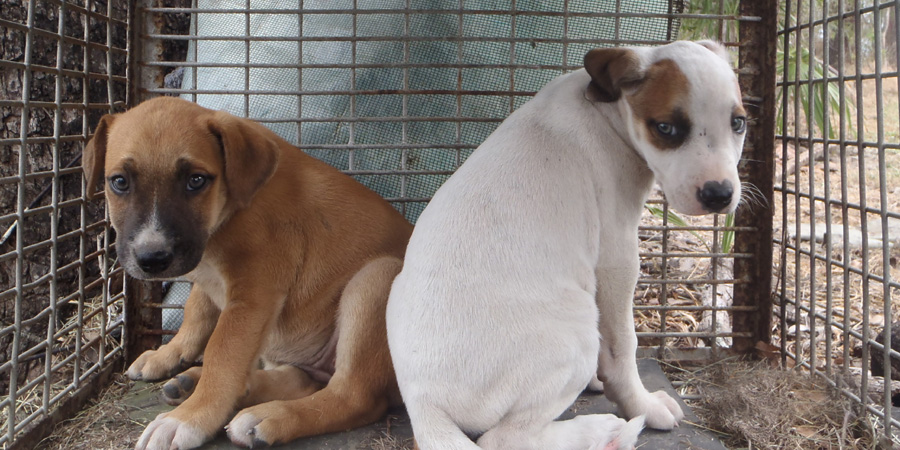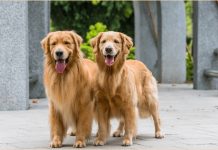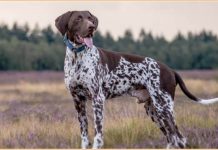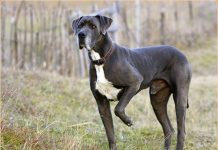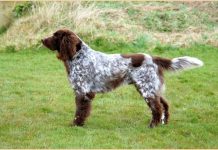The Bull Arab has origin from Australia and specifically developed to hunt feral pigs. They locate wild pigs and drag them to the ground and hold them by ear. They are commonly called Australian Pig Dogs are known for an immense sense of scent and ability to find the wild pigs even to an extent of 6 km.
Apart from active wild pig hunting, they are also excellent guard dogs. However, the aggressiveness of the breed, the tendency to attack humans, and a history of killing humans by biting and mauling make them unsuitable for the novice owner. They have been used in Police work, security detail, and search and rescue missions.
However, as per the RSPCA Australia, the reputation of Bull Arab being aggressive is implied to the public perception and media. Attacks on humans were attributed to this breed in Australia. However, Mackay Regional Council data shows that attacks were proportionally in lesser than the other dog breeds. Perception problems are due to a lack of socialization and by people who own the dogs.
Bull Arab Dog Breed Profile & Overview
[table id=9 /]
Bull Arab Dog Facts For Kids and Information
- The origin of Bull Arab is Australia.
- Bull Arab is a crossbreed of English Bull Terrier with Greyhound and German Shorthaired Pointer.
- The dog is famous for hunting and originally bred for feral pig hunting.
- They have strong abilities of sight and scent.
- These breeds are intelligent, easily trainable, and calm in temperament.
- It is known for the loyalty and love of people and used as a companion and therapy animal.
- They are large-sized breeds with a size of about 70 to 92 Pounds (Male), 66-68 Pounds (Female), and height of 25-27’’ (Male), 24-26’’ (Female).
- The dog is healthy due to the distinct gene pool it has inherited.
- Loyalty towards family and friendliness around children makes it a good family dog.
- The Bull Arab requires an active lifestyle and enough physical stimulus.
- The dog has strong predator instincts and will chase small animals around and bark at other dogs.
- They need early socialization and obedience training throughout life.
Bull Arab History
Mike Hodgens documented the origins of Bull Arab. He started developing this breed in 1972. The ideal characteristics he expected in the breed were strength, agility from English Bull Terrier, speed, sight of Greyhound, scent, the intelligence of a Pointer.
The Arab Bull certainly comprises 50% English Bull Terrier and 25% Greyhound. There is a question of the remaining 25%, either contributed by German Shorthaired Pointer or English Pointer along with Bloodhound and Saluki breeds.
Mike dropped breeding Bull Arabs in 1981 and completely stopped breeding dogs in 1989. Bull Arab developed into a versatile dog breed and became great wild pig hunter and an excellent guard dog. Major kennel clubs have not recognized Bull Arab.
Bull Arab Dog Appearance
The Bull Arab is the perfect height of strength and agility. It has a proportionate and well-balanced solid body structure. The dog has a medium to large build. The head is broad proportionate with the body with a power packing muzzle, shining slightly rounded eyes matching the coat color and have medium length ears.
Darker color dogs have brown eyes, and light breeds have amber or plain eyes. Nose is wide with large nostrils and color matches with the coat. They have powerful jaws that help them to pull and hold the pig to the ground.
The body and the legs are muscular and compared to the head size. The tail narrows towards the tip. The smooth and shiny coat is short and slightly harsh, has a variety of colors predominantly, white including black, brindle, silver, tan, and many more with white or light spots or patches. An undercoat that is soft and thick may be present in breeds of cold areas or during winter months.
Size
The height and weight of the dogs may vary on their lineage, but they have the following.
- Height– Male: 25 to 27 inches (63 – 69 cm); Female: 24 to 26 inches (60 – 66 cm).
- Weight – Male: 70- 93 lbs. (32 – 42 kg); Female: 65 – 90 lbs. (28 – 41 kg).
Behavior, Temperament & Personality
Bull Arab was bred to develop a breed that is both a great hunter but also calm and composed. They are highly intelligent, easily trainable. The Bull Arab is extremely loyal to its family and does well around kids but should watch closely. They may not respect the children in the family and demand a better position. However, their keen sense of smell combined with their hunting instinct may lead to chasing small animals.
The dog may be wary and aggressive towards strangers and supervise if left unleashed. They are highly excitable and dangerous breed. To ensure that the dog is in check, obedience training and socialization from an early age is compulsory. The dog requires a firm hand to control them, and an individual must not allow the dog to dominate them. They are quite playful and great watchdogs as well as search and rescue dogs. They are best at home without other pets.
Activity Requirements
Bull Arabs are highly energetic dogs with endless stamina to run for miles to hunt anything it perceives a threat. They are part sighthound and part scent hound that can chase anything they see and use nose to follow an interesting trail. They require a secured tall fence to prevent escape and avoid trouble.
They do not do well at public parks when smaller dogs are present. Take it for the long run or hiking for about 60 minutes daily. During exercise, incorporate training to fulfill their energy needs. It is the best partner if you are into sledding, as it can pull a sled with a person on it. You can take your pet for sports activities like dock diving. Find new ways and activities to drain Bull Arab energy and to make them physically healthy.
Training
The dog is aggressive and needs a dominant leader to socialize and train the dog. They need continuous training during their entire life along with early socialization. It is not recommended for first time dog owner as it is an aggressive breed and need a firm trainer to control.
Bull Arabs are working dogs, and training needs to engage in their minds. It requires one to 2 years of obedience training, and Puppy school is no match. Teach them basic commands first and play some games that help them to settle quickly.
Diet
The Bull Arab has a medium to large-sized body. They are highly active dogs with high energy levels. Their diet should have high-quality food consist of meat, eggs, and dry kibble. The diet should have adequate amounts of nutrients especially calcium for growing dogs.
Daily recommended food is 2.5 cups equally divided into two meals. They may take 0.5 to 1 cup of food divided into three equal meals for up to the age of seven months. Measure the weight at regular intervals and diet plans should formulate, based on age, size, metabolism, and activity level.
Habitat
The Bull Arabs are primarily hunting dogs with high energy that require an open space with a tall secure fence where they can be active physically to ensure proper growth. They do well in both hot and frigid conditions.
Grooming
The Bull Arab breed is easy and minimal maintenance dog. The dog has a short and soft coat, with some of them having an undercoat too. Brushing occasionally once a week with a natural bristle brush or slicker brush will be more than enough. They need brushing more often during the seasonal change to avoid loose hair falling on the floor or furniture. The short undercoat hair can float in air and fall in food or drinks when not brushed regularly.
The dog should only bathe when there is a need and best to bathe is during seasonal shedding to hasten the process. There is no need for a visit to a professional groomer. Clean their hanging ears, which may attract moisture and dirt with vet-approved solutions to prevent infections. Clip their nails once in a couple of weeks.
Shedding
The dog is a seasonal shedder. Having a short and fine undercoat, the dog in the shedding season is not that big of an inconvenience.
Lifestyle
The Bull Arab requires a highly active lifestyle. The breed belongs to a working group meant to accompany hunters. They are ideally suited to an environment that occupies them with work. They require daily exercise or physical activity to channelize their energy and stamina If raised in urban areas.
These dogs are not meant for apartments and are suitable for houses that have open space. Lack of physical activity may encourage destructive tendencies in these dogs. An individual having a sedentary lifestyle should not adopt these dogs.
Predators
Being developed specifically for hunting, these dogs have high prey drive. They have heightened scent tracking ability along with physical strength and agility, making them excellent hunting dogs. Supervise the dog always when around other animals. The dog requires active socialization throughout life, beginning from an early age. A well-trained Bull Arab will always be obedient and under the command of its owner.
Bull Arab Breeding
The Bull Arab was developed by crossbreeding multiple breeds. Different lines might have distinct characteristics depending on the breeder. They comprise 50% English Bull Terrier, 25% from German Shorthaired Pointer, and 25% Greyhound. Some of these may have some part of Blood Hounds or Saluki in them, while others may not.
The purpose behind the breeding is to get speed, strength, stamina, and superior scent tracking in one package. Their scrutinized breeding has resulted in the Bull Arab, one of the best hunting breeds. The litter size of the female is around 7 to 9 puppies.
Life Span
The Bull Arab has a higher life expectancy as compared to other breeds of comparable size. They may live anywhere from 12 to 15 years.
Bull Arab Health Issues
Bull Arab dogs are not Hypoallergenic. The Bull Arab developed by crossbreeding multiple dog breeds with a distinct gene pool. The wider gene pool ensures a few genetic problems in the offspring. Good breeding techniques and scrutinized breeding based on the traits shown by a generation helps to lower genetic diseases.
Also, being a new breed and unrecognized one, there is a lack of research on the breeds health issues. The dog is healthy, and routine vaccinations and check-ups can help to keep the best health.
They are less prone to health issues rather than accidents. They may face some health issues in their life like that of other dog breeds that include Epilepsy, Cataracts, Primary Lens Luxation, Bloat, and Cryptorchidism.
- Epilepsy : It is a neurological disorder characterized by unprovoked, recurrent uncontrolled seizures due to brain abnormalities that affect looks and behavior. It may range from a twitch to uncontrollable shaking that lasts less than a minute to longer. The reasons include liver diseases, cancer, stroke, electrolyte problems, low or high blood sugar, anemia, and Injury, etc.
- Cataracts : It is an opacity in the lens of the dog’s eye that causes blurry vision. Small-sized cataracts may not cause many problems, but they should be checked because the denser and thicker they become that lead to blindness. The reasons are old age, trauma to the eye, and other inherited conditions.
- Primary Lens Luxation : PLL, is characterized by the degeneration of the zonular fibers that lead to dislocation of the lens of an eye. Zonulas are fiber strands that keep the lens in its place behind Iris and Pupil.
- Bloat : Gastric Dilatation is a condition of gas filing in the stomach, and Gastric Dilatation and Volvulus is gas-filled stomach twisting on itself. These two are considered Bloat that causes shock which obstructs blood flow. Gastric Dilatation can be treated by pumping the stomach but the GDV requires emergency surgery.
- Cryptorchidism : It is a condition in which one or both the testicles fail to descend to the scrotum. Testes normally develop near kidneys and descend to scrotum at two months of age or rarely bit later by 6 months of age. If two testicles are not descended, it may lead to infertility. The complication may include Spermatic cord torsion in which it twists on itself that leads to sudden abdominal pain. Other complications include the retained testicle that may turn into cancer.
Pet Names
- Male : Duke, Sammy, Milo, Jack, Max, Tucker
- Female : Ellie, Riley, Coco, Zoey, Gracie, Maya
Things To Consider Before Buying
Pros
- They are best hunting dogs and companion dogs
- They are intelligent, easily trainable
- Bull Arabs are moderate shedders and are low maintenance dogs.
- Loyal to family and does well with children.
Cons
- Not suitable for first time dog owner and require firm leader to control them
- Require lifelong obedience training
- They are aggressive breeds
- Not suitable for apartment lifestyle
- Not Hypoallergenic
Bull Arab Characteristics
[table id=10 /]
Bull Arab FAQs
[sc_fs_multi_faq headline-0="h3" question-0="Is A Bull Arab A Good Family Dog?" answer-0="Bull Arab is a versatile breed known for their love and loyalty to their families. It is a good companion dog and guard dog. It is protective of children but should be watched to avoid trouble due to their aggressiveness and hunting instincts. There are instances of Bull Arab attacking humans, so require early socialization and obedience training entire life, and only a dominant leader can control the dog." image-0="" headline-1="h3" question-1="Is a Bull Arab a Dangerous Dog?" answer-1="Bull Arab is a large breed bred for hunting, which is a high energy breed. The Bull Arab reputation of being an aggressive breed has implied to media and public perception. The strongly built breed has stamina and high prey drive that can run miles. They have a history and instances of attacking humans and even killed them by Mauling and Biting. They require early socialization and training entire life." image-1="" headline-2="h3" question-2="What breeds make a Bull Arab?" answer-2="Bull Arab was developed by breeding English Bull Terrier, Greyhound, and German Shorthaired Pointer. But some have instincts of Bloodhound and Saluki breeds. It is a mix of 50% English Bull Terrier, 25% Greyhound, and 25% German Shorthaired Pointer." image-2="" headline-3="h3" question-3="How big is a Bull Arab?" answer-3="Bull Arab is a large-sized breed with a height of 25-27’’ (Male), 24-26’’ (Female), and weight of 70 to 92 Pounds (Male), 66-68 Pounds (Female)." image-3="" headline-4="h3" question-4="Do Bull Arabs shed hair?" answer-4="Bull Arabs have a short and smooth coat. They are moderate shedders and shed during seasons. Regular weekly brushing will help to control loose hair and during the season, it may require grooming often." image-4="" headline-5="h3" question-5="Is a Bull Arab a Pitbull?" answer-5="Bull Arab is a large pure breed originated in Australia while Pitbull is a medium-sized crossbreed from the United States." image-5="" count="6" html="true" css_class=""]

